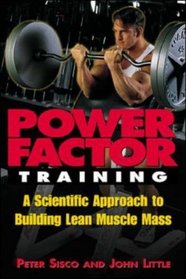Really interesting approach to weight training. It's based on the application of the principle that muscles only grow in response to a stimulus that exceeds their current capability combined with sufficient rest to allow them to adapt.
Rather than the traditional approach to building muscle mass of using a relatively small number of reps performed over a full range of motion with relatively "heavy" weight, the authors propose using a relatively small number of reps performed over an extremely limited range of motion with "very heavy" weight.
Their idea is that since muscle growth is directly related to the amount of "overload" that can be applied as a stimulus the objective of "mass building" exercises should be to maximize the overload in order to maximize the stimulus. Using such a small range of motion (1-2") you are able to safely handle much larger weights, and thereby apply a much larger overload as a stimulus to get the muscle to grow.
They contend that since its the amount of overload that determines the muscles growth response a large range of motion isn't really required to accomplish the primary objective of a "mass building" exercise. They contend that strength and flexibility are really two different training objectives that require two very different sorts of exercises. They contend that the best way to get "strong & flexible" is by combining heavy overload training exercises with a traditional stretching program, not by using large range of motion exercises in the strength portion of your training regimen.
They describe how to safely perform limited range of motion versions of all of the standard exercises and lay out a pretty detailed and flexible tracking system based on the principle that progressive overload coupled with sufficient rest & recovery are the keys to muscle growth.
I used it for a 6-8 month training period and was pleasantly surprised by how well it worked. The exercises were tough, but seemed safe to perform since the range of motion was so small. They did seem to provide a stronger growth stimulus and the recommended recovery periods essentially limited my strength workouts to 2X per week. Didn't really notice any significant loss in flexibility.
Bottom Line: Any training program gets stale after a while. If you want to keep challenging your body to respond you need to change your routine around every 4-6 months. If you're looking for something different this would definitely challenge your body in a much different way and would certainly be worth giving a shot.
Rather than the traditional approach to building muscle mass of using a relatively small number of reps performed over a full range of motion with relatively "heavy" weight, the authors propose using a relatively small number of reps performed over an extremely limited range of motion with "very heavy" weight.
Their idea is that since muscle growth is directly related to the amount of "overload" that can be applied as a stimulus the objective of "mass building" exercises should be to maximize the overload in order to maximize the stimulus. Using such a small range of motion (1-2") you are able to safely handle much larger weights, and thereby apply a much larger overload as a stimulus to get the muscle to grow.
They contend that since its the amount of overload that determines the muscles growth response a large range of motion isn't really required to accomplish the primary objective of a "mass building" exercise. They contend that strength and flexibility are really two different training objectives that require two very different sorts of exercises. They contend that the best way to get "strong & flexible" is by combining heavy overload training exercises with a traditional stretching program, not by using large range of motion exercises in the strength portion of your training regimen.
They describe how to safely perform limited range of motion versions of all of the standard exercises and lay out a pretty detailed and flexible tracking system based on the principle that progressive overload coupled with sufficient rest & recovery are the keys to muscle growth.
I used it for a 6-8 month training period and was pleasantly surprised by how well it worked. The exercises were tough, but seemed safe to perform since the range of motion was so small. They did seem to provide a stronger growth stimulus and the recommended recovery periods essentially limited my strength workouts to 2X per week. Didn't really notice any significant loss in flexibility.
Bottom Line: Any training program gets stale after a while. If you want to keep challenging your body to respond you need to change your routine around every 4-6 months. If you're looking for something different this would definitely challenge your body in a much different way and would certainly be worth giving a shot.




